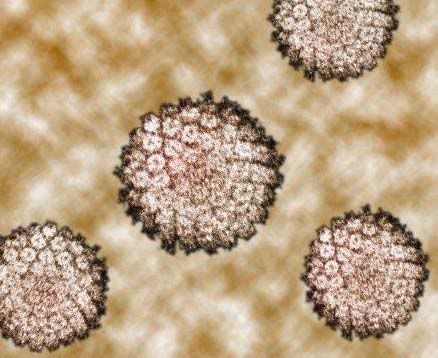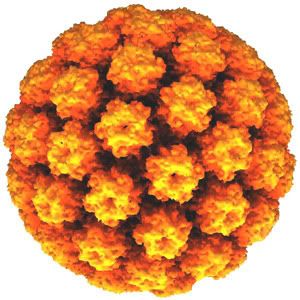华陀再世
一个中国医学生(CMG)在美国的生活。。。The virus notorious for causing cervical cancer in women also turns up frequently in men and can hang on unnoticed for months or even years, researchers report online March 1 in Lancet. The study solidifies earlier research indicating that human papillomavirus is highly prevalent in men and strengthens the case for vaccinating men and boys against it, the report’s authors say.

There are dozens of types of HPV, including more than 40 that can be transmitted sexually. Some can cause cancer. Two vaccines, Merck’s Gardasil and GlaxoSmithKline’s Cervarix protect against two types of cancer-causing HPV. Both vaccines are approved and recommended for girls and young women. Gardasil is also recommended for boys up to age 18 since its protection extends to two additional types of HPV that cause genital warts in males and females.
It’s widely assumed that limiting the virus in men or women would diminish its spread in the whole population. But while HPV has been extensively studied in women, its prevalence is less well understood in men, says Joseph Monsonego of the Institute of the Cervix in Paris, writing in the same Lancet issue. For that reason, he says, the new study results “are of substantial interest.”
Starting in 2005, epidemiologist Anna Giuliano of the H. Lee Moffitt Cancer Center & Research Institute in Tampa, Fla., and an international team of researchers recruited more than 4,000 men living in Brazil, Mexico and Florida into a study of HPV. The new study reports on the first 1,159 of these volunteers. Their average age was 32 and none had been vaccinated against HPV. Swabs of the penis and genital area of each man revealed that 50 percent were infected with at least one HPV type upon enrollment.
The researchers repeated these exams every six months, and the men completed personal-history questionnaires. Over a median of 28 months, the group acquired 1,572 new HPV infections.
The human immune system can clear HPV out of the body, and the men wiped out most of their new infections during the study period. But it took a median 7.5 months. Median clearance times didn’t vary substantially among the countries, but did vary between HPV types. Some cases lingered as long as 24 months in the men.
HPV 16 is the type responsible for the most cervical cancers in women and is covered by both vaccines. It took a median of 12 months to clear. “It’s hanging around longer, and it’s completely asymptomatic,” Giuliano says. “You don’t even know you have it.” This silent infection means a person can transmit this HPV type for longer periods and “might help explain why HPV 16 is one of the most common types in both men and women,” she says.
The data also reveal that men who reported having 10 or more sexual partners in their lifetimes had roughly twice as many HPV infections as did men who had had one partner.
Giuliano says many insurance programs cover HPV vaccination in boys up to age 18.
Male circumcision and the use of condoms have shown little protection against HPV infection, Monsonego says. “HPV vaccination in men will protect not only them but will also have implications for their sexual partners,” he says.
Giuliano says she expects to have data on the full group in three years.
- By Nathan Seppa ScienceNews
今天在《柳葉刀》雜誌上刊登的一篇文章稱,他們對巴西、墨西哥和美國18到70歲的男性做了調查,一半的人有生殖器人乳頭狀瘤病毒感染。
除了會致女性宮頸癌,人乳頭狀瘤病毒還會致疣、生殖器癌和肛門癌,兩性皆有。在過去的幾年中,科學家還發現,這種病毒也可致頭部和頸部癌症。
美國國家癌症研究所專家估計,2010年美國全國出現約8000例口咽(扁桃體和舌根部)癌,其中65%為人乳頭狀瘤病毒感染,且80%為男性。
這些HPV相關癌症的發病率正在上升,而對於像嘴和喉部因吸煙和喝酒而發病的比率正在下降。
50%的人感染一種可以致癌的病毒聽起來確實很恐慌。但如何正確看待這個風險,現有的發現還不足以解釋。
約90%的人感染的HPV病毒會在約兩年內自行消失。人乳頭狀瘤病毒株眾多,但可導致癌症只是極少數。只有約6%的男性有生殖器感染HPV16,這種病毒與90%的頭部和頸部癌症有關。而只有約0.6%的男性口腔標本上含有HPV16。有多大比例的人會患癌還尚不清楚。
該研究的結果也勢必帶來是否應該將HPV疫苗推廣同樣用於男性的討論。





十八岁以下的女孩一定要打。主要是性传染,后果是子宫颈癌。打了HPV疫苗后,女孩子就会减少或消除患子宫颈癌的危险。妈妈都大于十八岁,可能都感染过了,就不用打了。